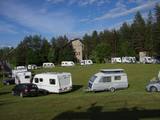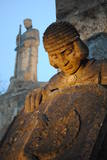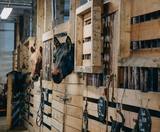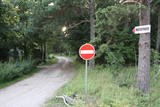| Нo | Название | Описание |
|---|---|---|
|
Впервые упоминание о Ливаны, как о крупном населенном пункте, встречается в 1533 году, когда тогдашний землевладелец Ливен основал поместье и назвал его своим именем - Ливенгоф. В 1678 году здесь возвели первую католическую церковь. Город сильно пострадал во время обоих мировых воин. Название Ливаны связано со стеклянными изделиями. В 1887 году здесь был построен стекольный завод, который в наши дни прекратил свою деятельность. |
||
|
An impressive two-trunk tree at the Nigliņi homestead, this is one of the most impressive trees on the Liv Shore. The Liv language teacher Zoja Sīle was born here. The Medieval Old Cemetery Hill – once used as burial grounds – is nearby. |
||
|
Atrodas sporta un atpūtas kompleksā „Trīssaliņas”. No torņa paveras pievilcīga apkaimes ainava, kas īpaši skaista ir pieneņu ziedēšanas laikā. |
||
|
Хозяйство Piesta Kuusikaru расположено в лесу Вяндра ‒ в уезде Пярнумаа. Здесь ждут в гости каждого, кому интересно послушать рассказ о том, как эта семья начала хозяйствовать на селе и теперь производит невероятно вкусные продукты из яблок. В хозяйстве можно попробовать любые продукты, а то, что понравится, купить навынос. Здесь также можно отлично отдохнуть с семьей. |
||
|
In the summer season we offer trips by raft and boats, camps for children, an area for organizing events, camping for the night. In the winter season "Baili" has a ski center - downhill ski tracks, ski and snowboard equipment rental, instructor services. Catering offer in a cafe. |
||
|
”Cīruļi” atrodas 5 km attālumā no Rūjienas, Jeru pagastā. Īpašums ir pārmantots no paaudzes paaudzē, īpašniekiem vienojoties kopīgā mīlestībā uz ziediem, dažādu augu audzēšanai pārvēršoties arī par vaļasprieku. Dārzā atrodamas arisēmas, ramondas, magnolijas, knifofijas, rodžersijas, ligularijas, rožainā radiola, ehinācijas un vēl daudz vairāk pazīstamu, skaistu augu. Pavasaris iesākas ar sniegarožu un daudzo sīpolpuķu plaukšanu, vēlāk - krāsainie īrisu ziedi un trauslās astilbju skaras. Daudz skaistuma un krāsainības puķu dobēm piedod heihēras un hostas, kas priecē līdz pat vēlam rudenim. Dārzā aug arī skujeņi, vīteņaugi un katru gadu ražojoši vīnogulāji, kas veido pašu dārza telpu.
|
||
|
Brāļu kapos apbedīti aptuveni 2000 karavīru. Pirmos kritušos strēlniekus — Andreju Stūri, Jēkabu Voldemāru Timmu un Jāni Gavenasu — apbedīja 1915. gada 15. oktobrī. Sākot ar 1915. gadu, kapos sāka apbedīt Pirmā pasaules kara kaujās kritušos strēlniekus, vēlāk Februāra revolūcijas laikā nošautos kareivjus. Stučkas valdības laikā 1919. gada pavasarī šeit apbedīja Brīvības cīņās pret vācu vienībām un Dienvidlatvijas brigādi kritušos latviešu strēlniekus. Pirmās Latvijas brīvvalsts laikā Brāļu kapos apbedīja ap 800 Latvijas armijas kareivjus un virsniekus. 1941.—1942. gadā Brāļu kapos apbedīja 15 nacionālos partizānus, kā arī pārapbedīja komunistiskā režīma terora upurus. Līdz 1944. rudenim šeit apbedīja arī vairākus desmitus bijušās Latvijas armijas virsnieku un karavīru, kuri bija dienējuši Latviešu policijas bataljonos un Latviešu leģionā. Abās pusēs ieejas vārtiem (augstums 10 metri, platums 32 metri) divas jātnieku skulptūru grupas (augstums 3,3 metri). Liepu gatve (205 metri) savieno vārtus ar galveno terasi, kuras centrā novietots 1 metru augsts mūžīgās uguns altāris, bet abās pusēs ozolu birzis. No terases abpusējas kāpnes ved uz regulāri veidotu kapulauku. Tā malās atrodas divas "Mirstošo jātnieku" skulpturālās grupas (augstums 3,6 metri), vidus daļā atrodas augstcilnis "Kritušie brāļi". Pret katru kapa vietu novietota smilšakmens vai plienakmens plāksnīte ar kritušā uzvārdu un vārdu vai uzrakstu "Nezināms". Ansambli noslēdz 6 metrus augsta siena ar Latvijas apriņķu un pilsētu vēsturiskajiem ģerboņiem. Pie sienas atrodas četri senlatviešu karavīru tēli, kas simbolizē Latvijas novadus - Kurzemi, Zemgali, Vidzemi un Latgali, bet tās centrā uz 9 metrus augsta sienas masīva paceļas monumentāla figūra "Māte Latvija", kas noliekusi vainagu pār kritušajiem dēliem. Brāļu kapu memoriālais ansamblis ir izcirsts no Allažu šūnakmens, izmantots arī Itālijas travertīns un smilšakmens. Pirmmetu izstrādāja tēlnieks Kārlis Zāle, arhitekts Aleksandrs Birzenieks, Pēteris Feders un Andrejs Zeidaks. |
||
|
Vidzemē, Valmiermuižā, 19.gs. celtā ēku kompleksā, ko iekļauj mūra žogs, atrodas Valmiermuižas stallis un Valmiermuižas jātnieku skola. Tajā saimnieko Jurašu ģimene - zirgkopju, zirgu selekcionāru un vetārstu ģimene daudzās paaudzēs. Ir iespēja doties izjādēs, ekskursijās, kā arī tiek rīkotas radošās nometnes bērniem. |
||
|
Хозяйство «Мазбуркас» находится в живописном месте между шоссе Рига – Вентспилс (А 10) и Тукумсом. В окрестностях хозяйства – живописный и холмистый ландшафт. На южных склонах холмов раскинулись поля виноградника, на которых выращивают ~ 60 сортов винограда. Посетители могут приобрести виноград, или собрать его сами. Из винограда хозяйка производит прекрасные вина, которые награждены престижными, в том числе международными призами. Вторая специализация хозяйства – разведение овец. Желаюшие могут посмотреть стадо, а также, заранее договорившись, приобрести баринину. С целью приема гостей была построена широкая деревянная платформа. Хозяйка Гунта Ниедра охотно делится опытом и консультирует тех, кто начинает заниматься овцеводством. |
||
|
Atrodas Cenas tīreļa dabas takas sākumā. No tā labi pārskatāma kūdrā izstrādātā Cenas tīreļa neliela daļa. |
||
|
The hosts produce mixtures of dried herbs and vitamin tea in a full cycle - from seeds to a packet of spices. The farm beds and greenhouses grow a wide range of vegetables and herbs - dill, onions, garlic, chives, mint, sage, thyme, coriander, hyssop, tarragon, peppermint, chili, basil. Also used wild plants - nettle, gooseberry, viburnum, dandelion, yarrow, oregano. |
||
|
Всего лишь в 20 минутах езды от Пярну, в старом здании лесничества Tõstamaa, находится кафе Amps & Lonks, которое предлагает путешественникам немного отдохнуть и подкрепиться пиццей, приготовленной из свежих местных продуктов. Особой популярностью пользуется пицца с говядиной, выращенной здесь же, в хозяйстве, и свежий салат. Также можно делать заказы заранее. |
||
|
Из Риги маршрут идет на козью ферму, где можно пообщаться с милыми смешными животными и отведать эксклюзивные сыры. Затем посетите поместье Малпилс и отведайте ассорти из местных сыров, изготовленных из коровьего молока. Потом маршрут поворачивает в сторону реки Даугавы и ведет в Скривери, где можно попробовать восхитительное домашнее мороженое и традиционные ириски «Коровка» ручной работы. А затем направляйтесь к развалинам легендарного Кокнесского замка. На следующий день маршрут идет в этнографическое действующее фермерское хозяйство, расположенное в живописном местечке под названием Яунпиебалга, и в семейное предприятие по производству сыра и макаронных изделий в Рауне. Неподалеку находится производство глиняных изделий, расположенное в стенах бывшего кирпичного завода, где можно понаблюдать за тем, как вручную изготавливаются керамические изделия. Затем вас ждет осмотр достопримечательностей в Цесисе, с его Старым городом и средневековым замком Ливонского Ордена. А далее, маршрут ведет на ферму, где выращивают коноплю, и где вы сможете попробовать ее, приготовленную традиционным способом. Далее по плану экскурсия и дегустация на фабрике мороженого в Руйиене. Остановитесь на бывшей мельнице, где до сих пор используется и можно посмотреть старинное оборудование для обработки шерсти. На пути обратно в Ригу, маршрут ведет вдоль побережья. Посетите музей величайшего в мире лгуна – Мюнгхаузена, где вас развлекут историями о его фантастических приключениях, навестите ловцов миног и прогуляйтесь по песчаному пляжу. |
||
|
35 m wide and 0.5 m high, the
|
||
|
Кафе Ugandi ‒ это уютное место в самом сердце Отепя, где царит теплая атмосфера, довольство, приятные и чистые вкусы. Войдя сюда, Вы сразу же почувствуете аромат качественного кофе и сладких булочек. Большая витрина переполнена вкусными пирожными ‒ их можно и попробовать на месте, и взять с собой. |
||
|
Находится со стороны дороги Двиете – Бебрене. Восстановленное строение возводилось в 1874 году. После Первой мировой войны до 1929 года амбар использовался как моленная до тех пор, пока не была восстановлена Двиетская католическая церковь.
|
||
|
Muiža vēsturiskajos dokumentos pirmoreiz ir pieminēta 16. gs. Tagad redzamā vienstāva kungu māja ir vairākreiz pārbūvēta laikā no 17. – 19. gs. 1997. g. ēku vēlreiz atjaunoja un tagad tajā atrodas viesu nams un Vilsandi nacionālā parka apmeklētāju centrs, kur var iegūt ne tikai vērtīgu informāciju, bet arī apskatīt Vilsandi apkārtnē atrastās fosilijas. No Lonas muižas var uzsākt pārgājienu uz Vilsandi salu. Vienā no muižas ēkām ir izveidota Vilsandi nacionālajam parkam veltīta ekspozīcija. |
||
|
Находится в 130 м от Берзкрогского перекрестка (напротив АЗС Statoil). Поддерживает сотрудничество с местными производителями, продукты которых можно попробовать и купить (в т.ч. сувениры) на месте. Латышская кухня: Серый горох с салом, крупяная каша. |
||
|
Atrodas 0,3 km ziemeļos no Vecpiebalgas pilsdrupām. Ap 10 m augsto, bet visnotaļ izteiksmīgo Grišku kalnu sauc arī par Piebalgas, Balgas un Veļķu pilskalnu. 13. gs. šeit bijusi svarīga apmetnes vieta ar mākslīgi nostāvinātām nogāzēm un dziļu aizsarggrāvi. Vēstures notikumi ir atstājuši ap metru biezu kultūrslāni. Bezlapu laikā no kalna paveras skats uz Vecpiebalgas baznīcu un pilsdrupu vietu. Pilskalna piekājē ir aka ar Griškavotu. |
||
|
В настоящее время территория бывшего советского противовоздушного дивизиона в Юркалне находится в частной собственности, где обустроена мототрасса.
|
||


























